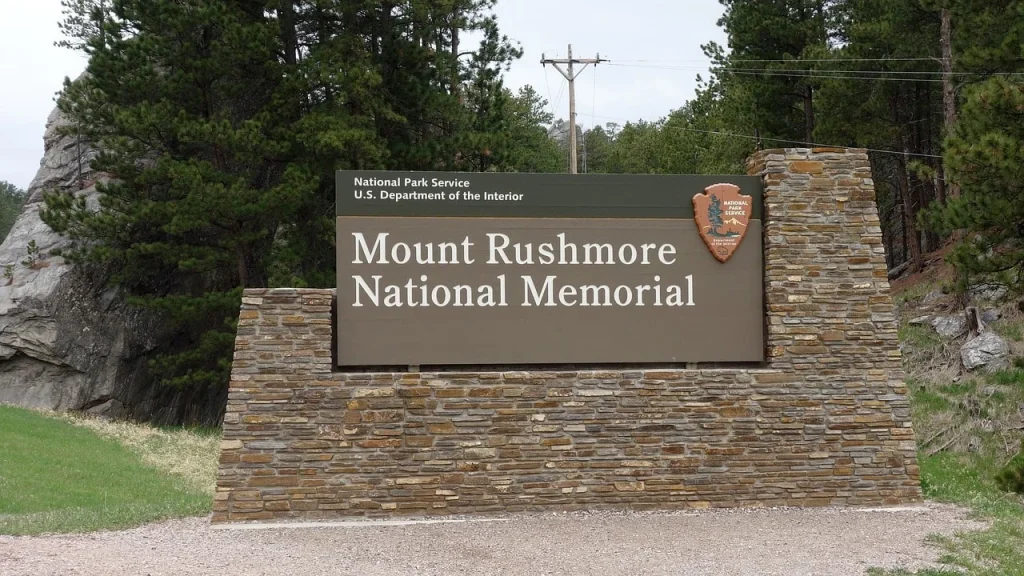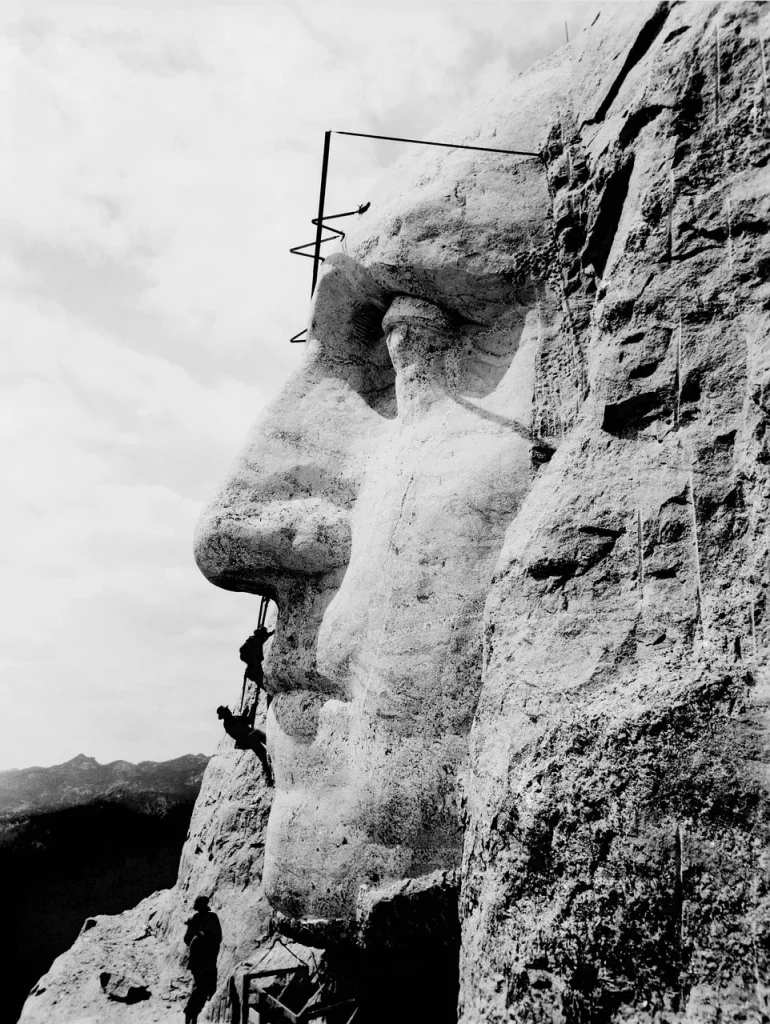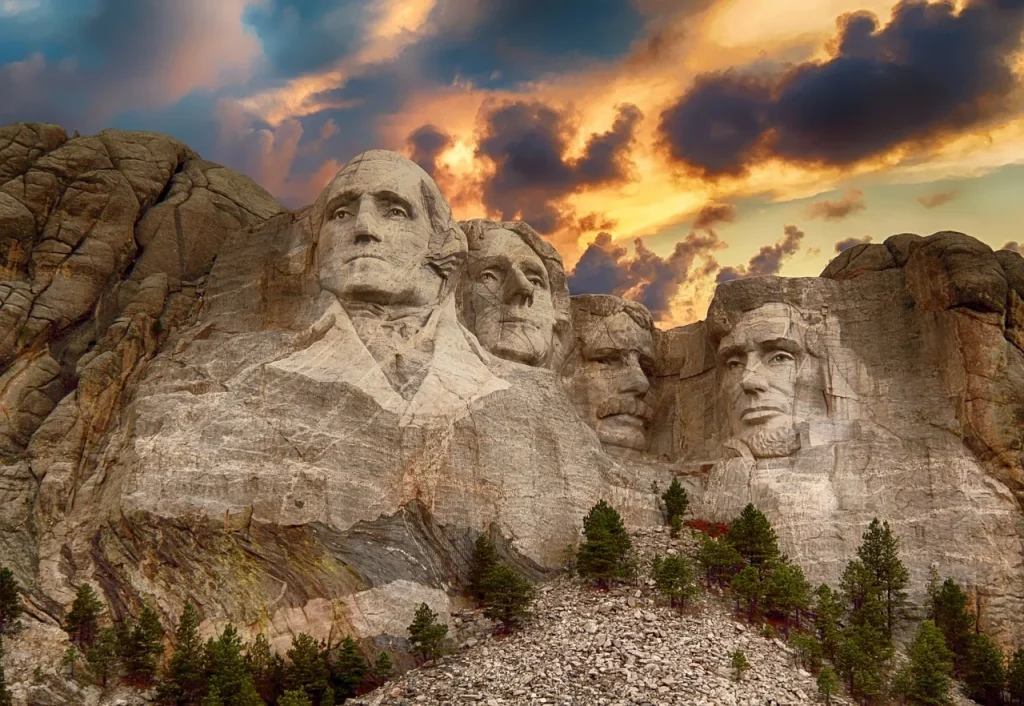What do George Washington, Thomas Jefferson, Theodore Roosevelt, and Abraham Lincoln have in common? Aside from their crucial roles in American history, they all share a permanent residence on the face of Mount Rushmore, looking out over South Dakota’s scenic Black Hills.
But behind this awe-inspiring sight lies a tapestry of stories, challenges, and trivia that many aren’t aware of. In this article, we’re going to uncover some interesting facts about Mount Rushmore, shedding light on its creation, symbolism, and the extraordinary efforts that went into its construction.
Whether you’re a history buff, a travel enthusiast, or simply curious, these facts will provide you with a deeper understanding and appreciation of one of America’s most iconic landmarks.
Let us place there, carved high, as close to heaven as we can, the words of our leaders, their faces, to show posterity what manner of men they were
John Gutzon de la Mothe Borglum
Mount Rushmore Facts
Before starting our journey, remember that there is a quiz at the end of this page. Read each fact carefully to prove you’re an expert on this iconic monument.
- The idea for this monument was originally conceived to promote tourism in South Dakota.
- Gutzon Borglum, the lead sculptor, began work on the project in 1927 but didn’t live to see its completion.
- The project cost just under $1 million at the time, which is equivalent to over $17 million today.
- Despite popular belief, the monument does not appear on the U.S. nickel; that’s actually Monticello.
- The workers had to climb 700 stairs daily to reach the top of the mountain for carving.
- A total of 400 workers contributed to its construction, with surprisingly no fatalities.
- The presidents’ faces are as tall as a 6-story building, measuring around 60 feet high.
- Originally, the design included both the presidents’ heads and torsos, but funding and time constraints limited it to just the heads.
- Thomas Jefferson was initially started on George Washington’s right, but due to poor rock quality, the face had to be blasted off and started over on the left.
- Lakota Sioux consider the Black Hills, the monument’s location, to be sacred land.
- The Hall of Records is a hidden chamber behind the monument, intended to house America’s most important documents for posterity.
- Dynamite was the main tool for carving, removing approximately 90% of the unwanted rock.
- The sculptor, Borglum, died in March 1941, and his son, Lincoln Borglum, completed the project the same year.

- Each president was chosen for their representation of the nation’s birth, growth, development, and preservation.
- No chemical sealants have been applied to the faces; they endure the elements through natural granite erosion, which erodes one inch every 10,000 years.
- The project was as much a feat of engineering as it was of artistry, utilizing advanced techniques of the time.
- Borglum used miniature models to ensure accuracy, scaling the mountain sculptures at a ratio of 1 inch to 1 foot.
- Honeycomb areas, where the granite is softer and erodes more quickly, are constantly monitored and patched to prevent water damage.
- A special bill was passed in Congress to add Susan B. Anthony to the monument, but it was vetoed by President Bush in 1991, citing the artist’s original intent.
- The original design was altered due to insufficient funding, resulting in the incomplete depiction we see today.
- The creation process involved precise blasting and detailed finishing work by hand.
- Workers wore special goggles to protect against flying debris, with many going on to develop silicosis from the dust.
- The monument is illuminated by lights for several hours after sunset, making it a breathtaking sight at night.
- Despite its grand scale, there’s no internal framework or support within the carving; it’s entirely solid granite.
- An annual fireworks display was held for many years but was canceled due to fire hazard concerns before being reinstated in 2020.
- The site attracts over 2 million visitors each year, drawn to its historical significance and natural beauty.
- Each nose on the monument is about 20 feet long, with George Washington’s nose being slightly longer due to the rock’s layout.
- The monument’s construction was deemed a “Shrine of Democracy”, symbolizing the country’s ideals and freedom.

- Interestingly, a time capsule containing the story of the mountain and the flags of all the states was placed in the Hall of Records in 1998.
- Lincoln Borglum, the sculptor’s son, opened a museum near the base of the monument in 1971, featuring tools and photographs of the construction.
- Environmentalists have raised concerns over the years about the impact of tourism and construction on the surrounding Black Hills National Forest.
- The carving process created a rock pile at the base, known as the “scree,” which consists of over 450,000 tons of granite.
- There’s an ongoing debate about the monument’s presence on Native American land, with proposals for additional carvings to honor indigenous leaders.
- A lightning rod is installed atop each head to prevent erosion from lightning strikes, highlighting the practical challenges of maintaining such a massive outdoor sculpture.
- The monument has appeared in numerous films and television shows, becoming an icon of American culture and a symbol of patriotism.
- The presidents were selected to represent key phases of American history: Washington for independence, Jefferson for expansion, Roosevelt for development, and Lincoln for preservation.
- High winds and harsh weather conditions made the construction process even more challenging, with workers often enduring freezing temperatures.
- The site’s elevation provides a unique ecosystem, supporting species like the Ponderosa pine, which is adapted to the harsh conditions.

- It took 14 years to complete the monument, with work officially ending in 1941.
- The monument has no dedicated funding for preservation, relying on entrance fees and donations for maintenance and repairs.
- A secret room was planned to house important documents but was left unfinished due to funding issues, though it was completed in its basic form later.
- The impact of acid rain and pollution on the monument is a concern, with efforts underway to monitor and mitigate any potential damage.
- Each year, climbers inspect the monument for cracks and wear, ensuring the safety and integrity of the structure.
- The location was specifically chosen for its granite composition and sunlight exposure, allowing the faces to be visible from great distances.
- The creation of the monument involved controversy, including disputes over land rights and environmental impact.
- It’s not just a tourist attraction but also a site for scientific research, including studies on erosion and the effects of climate change.
- The monument has its own zip code, established to handle the volume of mail sent by visitors wishing to have their postcards canceled from this iconic location.
- Despite the hardships faced during its construction, including the Great Depression, the monument stands as a testament to American ingenuity and determination.
- The sculptor, Borglum, was involved in another monumental project, the Confederate Memorial Carving at Stone Mountain, Georgia, before committing to this iconic sculpture. His work on the latter project reflected his immense skill in creating large-scale public monuments and paved the way for his later achievements.
- Interestingly, the monument’s official dedication ceremony in 1927 was attended by President Calvin Coolidge, who wore a cowboy hat and rode on horseback to the event, symbolizing the American spirit and the blend of cultures in the national identity.
Mount Rushmore Myths

Now that we’ve explored the facts, let’s dive into another layer of its story: separating myth from reality. It’s time to shed light on the legends and tales that have surrounded this monumental site for years.
- The Presidents Were Chosen by the Sculptor Alone
The selection of the four presidents to be featured on Mount Rushmore was influenced by both the sculptor, Gutzon Borglum, and prominent political figures of the time. This collaboration aimed to represent the most important events in the history of the United States. - Mount Rushmore Is Finished
It was deemed complete in 1941 due to insufficient funds, although Gutzon Borglum originally had a more elaborate design in mind. The original plan included larger portraits and potentially additional figures or inscriptions. - The Site Was Chosen Only for Its Granite
While the quality of the granite was a significant factor, the location was also selected for its southern exposure and grand visibility. This strategic choice ensures the monument enjoys optimal lighting and is visible from a great distance. - The Monument Represents Universal Presidential Greatness
The presidents depicted were specifically chosen to symbolize the founding, growth, preservation, and development of the United States, representing key phases rather than an overall ranking of presidential greatness. - No Environmental Concerns Were Raised
Environmental concerns were not a major focus at the time of construction, but the project did face criticism for altering the natural landscape and for its impact on Indigenous lands, particularly the sacred Black Hills, which were taken in violation of treaties.
No products found.
Mount Rushmore FAQ

We are getting near the trivia section. Read these FAQs carefully, as they are your last stop before the quiz.
- Will Mount Rushmore be destroyed?
No, there are no indications that it will be destroyed. It remains an important symbol and a major tourist destination, despite its complex history. - Who is Mount Rushmore named after?
The name comes from Charles E. Rushmore, a New York lawyer, during an 1880s visit. It was named somewhat jokingly, but the name persisted. - Can you go inside Mount Rushmore?
There’s no public access inside the monument. Though there’s a Hall of Records behind the faces, it’s not open for tours. - Can you climb Mount Rushmore?
Climbing on Mount Rushmore is prohibited to protect both the monument and visitors, but the surrounding Black Hills offer plenty of hiking trails. - How was Mount Rushmore made?
Created between 1927 and 1941, the monument was sculpted using dynamite and detailed carving tools, removing around 450,000 tons of rock without any fatalities.
Mount Rushmore Trivia

Welcome to our Mount Rushmore quiz, where the only faces more stone-cold than the presidents’ are those of participants who score zero. Beware, or you’ll be turned into an honorary fifth face of disappointment!
Conclusion
To conclude, Mount Rushmore brings together art, history, and nature in a stunning display of American heritage. Behind the colossal faces etched in stone lie the untold stories of hundreds of workers, the vision of a dedicated sculptor, and the ideals of a nation.
This iconic monument continues to inspire awe and curiosity in millions of visitors each year, serving as a testament to the enduring spirit of America.
As we reflect on the grandeur of Mount Rushmore, one has to wonder: if the presidents could talk, what would they say about their rock-solid legacy? Or perhaps, who would win in a Mount Rushmore presidents’ staring contest? Let me know what you think in the comments.


